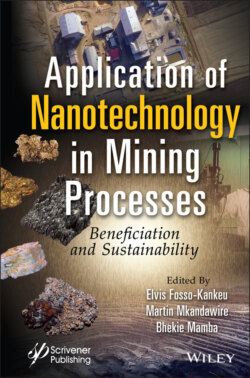Читать книгу Application of Nanotechnology in Mining Processes - Группа авторов - Страница 19
1.3.2 Principle REE Extraction Using PAMAM
ОглавлениеDespite the extensive application of PAMAM dendrimers, no report has outlined their direct use for the recovery of REEs from AMD. This can be attributed to the low pH of the acidic effluent, which instead favors the protonation of the terminal amine functional groups, producing cationic charge on their surfaces to deactivate their adsorptive capacity to metal ions through electric repulsive forces. However, suppose the surfaces of PAMAM dendrimers are functionalized with carboxyl functional groups such as succinic acid. In that case, it will protonate in the acidic effluent to anionic groups, which will increase the binding ability of the polymer with metal ions in the acidic solution via electrostatic attraction. Considerable research interest has been focused on using magnetic nanoparticles (MNPs) as supporting cores for dendrimers to remove heavy metals from wastewater due to their intrinsic magnetic property, which allows for convenient separation through the deployment of an external magnetic field [67]. This feature improves the economic viability of the separation and re-use of dendrimers in a wide range of applications [55]. Therefore, magnetic PAMAM dendrimer nanoparticles will be synthesized, and their surfaces functionalized with succinic acid (PAMAMCOOH@MNPs) (Figure 1.3) and used as a perfect absorbent to recover REEs from AMD.
Table 1.5 Use of PAMAM dendrimer for the removal of metal ions.
| Contaminants | Mode of removal | Study outcome | Reference |
| Cu2+ and Pb2+ | A single and binary component system using modified carbon nanotubes (CNTs) with four generations of poly-amidoamine dendrimer (PAMAM, G4) for the removal of Cu2+ and Pb2+. | The study was very effective, achieving high adsorption capacities for copper and lead (3333 and 4870 mg/g respectively). | [68] |
| Mn(II) | silica-gel supported amino- and ester-terminated polyamidoamine dendrimers. The adsorption of the contaminant in solution is dependent on the terminal group. | The results revealed that amino-terminated polyamidoamine dendrimers could be potentially used as promising adsorbents for the effective removal of Mn(II) from an aqueous solution. | [69] |
| Cd(II), Pb(II) and Cu(II) | As-synthesized magnetic graphene oxide nanocomposite was grafted polyamidoamine dendrimer. | The adsorption capacities of metal ions were 435.85, 326.729 and 353.59 mg g-1 for Cd(II), Pb(II) and Cu(II), respectively, which proves excellent removal ability of the metal ion from water and wastewater. | [70] |
| Hg2+ | Carboxyl-terminated hyperbranched poly(amidoamine) dendrimers grafted superparamagnetic nanoparticles with the core-shell structure for selective removal of mercury from the aquatic sample. | As a result, the carboxyl-terminated hyperbranched poly(amidoamine) dendrimers grafted superparamagnetic nanoparticles displayed excellent properties and rebinding ability toward Hg2+ ions. | [71] |
| Ni2+, Fe2+, and Fe3+ | Metal ion remediation using polyamidoamine dendrimers as a chelating agent. | Metal ion removal rates from simulated wastewater were evaluated for these metal ions, and the complexation of Ni2+ to internal tertiary amine sites occurred more rapidly than that of Fe3+, which was more rapid than Fe2+. | [72] |
Figure 1.3 Schematic of magnetic PAMAM succinamic dendrimer nanoparticle.
